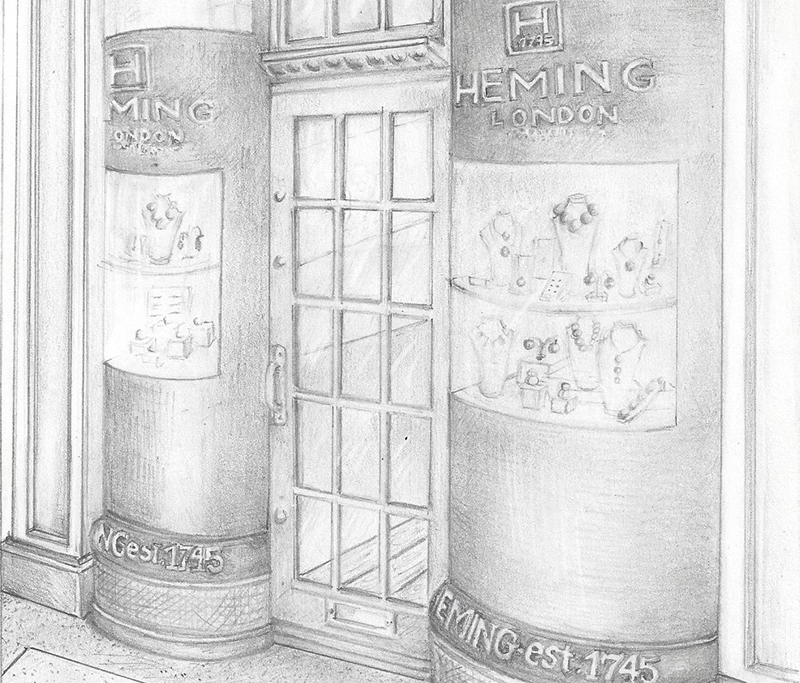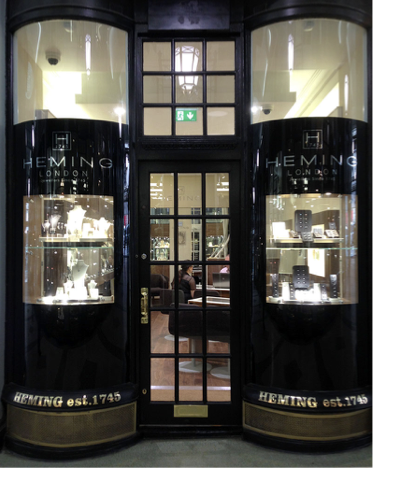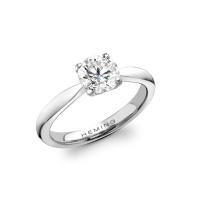
Sapphire
The name ‘Sapphire’ comes from the Greek word Sappheiros meaning blue stone.
In contemporary jewellery, ‘sapphire’ refers to crystals of the mineral Corundum ranging from a pure blue, through to violet, mauve and a variety of ‘fancy colours’ including yellow, orange, pink and green. Red corundum is known as ruby. The better known blue colour in sapphires is a result of the trace elements titanium and iron being present within the gemstone, a darker blue hue indicating a greater level of iron.
Sapphire crystals tend to form as bi-pyramidal hexagons, thicker in the centre and tapering towards the ends, or barrel-shaped hexagonal crystals. They are often striated and can also be found rounded as water worn alluvial pebbles.
Sapphire is the birthstone for the month of September and also the gemstone for the 45th and 65th wedding anniversary.
Care Guidelines
Sapphire ranks 9 on moh’s scale of hardness; with only diamond ranking higher at 10, this makes it a very practical, hard wearing gemstone. However it should always be handled with care and can still be damaged if mistreated. To clean sapphires, use warm soapy water and a soft toothbrush, then dry using a soft lint free cloth. Sapphire is relatively tough and will withstand most household chemicals, and also the effects of strong heat and light, but like with any precious gemstone you should avoid these effects where possible. When storing sapphires in a jewellery box, items should always be kept separate to avoid general abrasion to the gemstones’ surface.
History and Lore
 Sapphires have a rich history and are synonymous with royalty and romance.
Sapphires have a rich history and are synonymous with royalty and romance.
Sapphire has a number of associated legends: the ancient Greek and Roman kings and queens believed it protected the wearer from harm and envy; in the Middle Ages clergy would wear sapphires to symbolise heaven and Pope Innocent III stated that all bishops should wear rings made of pure gold and set with an un-engraved sapphire; the ancient Persians believed it symbolised the pedestal on which the world stood on, and the gems reflection was how the sky was given its blue colour.
Throughout history sapphires have been worn to make peace between enemies and to influence spirits. Wearing Sapphire is deemed to produce self-fulfilment, positive motivation, promote good health, it is a symbol of love, commitment, wisdom and integrity.
One of the largest, notable Sapphires is known as the ‘Millennium Sapphire’; it was carved by Alessio Boschi and is a tribute to the creative genius of humanity with over 130 figures depicting a great mind, inventor, or creator. It weighed in at 65,000 carats, and was discovered in Madagascar in 1995. In 2018 it was acquired by a Chinese company for $50 million.
In 2015 the largest star sapphire was found in Ratnapura, Sri Lanka and was named the ‘Star of Adam’ as a reference to the Muslim beliefs that Adam arrived in Sri Lanka and lived at Adam’s Peak after leaving the Garden of Eden. It weighed 1,404.49 carats and has been estimated at a value of over $300 million.
Perhaps one of the most iconic engagement rings in history is the 12 carats oval Ceylon sapphire surrounded by a cluster of round brilliant cut diamonds, given to Lady Diana Spencer by Charles, Princes of Wales. After her untimely death Princes William and Harry selected mementoes from their mother’s possessions. Prince Harry chose the Sapphire and diamond ring and Prince William chose a yellow gold Cartier Tank Francaise watch. Before Prince William proposed to Catherine Middleton the two Princes had exchanged the mementoes so that it could be given to her. Now worn by the Duchess of Cambridge the ring is said to be worth over £300,000.
Colour
 Sapphires come in a variety of colours and each one has its own quality of colour variations. Generally the less zoning of colour within the stone and higher intensity of colour the more valuable the sapphire. With blue sapphires the most valued are those that display a velvety blue to violetish blue, with medium to medium dark tones. Those that have the strongest level of saturation without darkening the stone or impacting the brightness will command the highest prices per carat. Stones which are greenish blue or display greenish blue pleochroism will be of a lower value. Other lower values will be given if the sapphire is too dark, too light, or greyish in colour.
Sapphires come in a variety of colours and each one has its own quality of colour variations. Generally the less zoning of colour within the stone and higher intensity of colour the more valuable the sapphire. With blue sapphires the most valued are those that display a velvety blue to violetish blue, with medium to medium dark tones. Those that have the strongest level of saturation without darkening the stone or impacting the brightness will command the highest prices per carat. Stones which are greenish blue or display greenish blue pleochroism will be of a lower value. Other lower values will be given if the sapphire is too dark, too light, or greyish in colour.
Sapphire can come in a rainbow of fancy colours which lend themselves to creating bold jewellery designs. The most famous of the fancy sapphire colours is an intensely saturated light pinkish orange to medium orange pink called ‘padparadscha’, derived from the Sinhalese for ‘lotus flower’. These strikingly coloured gems command a higher price per carat. Pink and purple sapphires range from red to purple hues but have a weaker saturation and lighter tone. Orange and yellow sapphires can present in a range of tones, the finest quality yellow has yellow to orangy yellow with vivid saturation, with the finest orange displaying a pure orange to red orange, medium in tone and vivid in saturation. Green sapphires are quite common, and are less marketable than the other colours and are therefore less expensive. They range from light to dark bluish green to yellowish green with weak saturation. Sapphires also come in a colour changing variety which are very rare. Under day light or fluorescent light the gem typically appears blue, and when placed under incandescent light it displays a violetish purple to reddish purple hue. This colour change effect to violet is caused by the presence of traces of vanadium.
Clarity
 With Sapphire, some inclusions within the stone are very common, as inclusion free sapphires are extremely rare, and very valuable. Sapphires are generally cleaner than their corundum counterpart ruby. The important factor of clarity with sapphire is how visible these inclusions are and this will help to determine the value of the gem, with heavily included sapphires reducing both transparency and brightness, and potentially causing durability issues. In some cases with Kashmir Sapphires the fine inclusions actually increase the value as they cause light in the gem to scatter giving a velvety appearance without reducing transparency. Typical needle inclusions in Sapphire consist of fine rutile intersecting at angles to produce a clarity characteristic termed ‘silk’. Other zones of colour, small crystals, or finger print like inclusions may also be present. Sapphire can sometimes benefit positively from these rutile ‘silk’ inclusions, whereby light within the stone is caused to scatter which creates an optical property called asterism or a star effect. These star sapphires are normally cut as domed cabochon to best display this effect. This phenomenal star effect can be seen as 4, 6, or 12 rays, with 12 rays being very rare. Two different types of inclusion oriented in different directions are required to create a 12 ray star, one which is rutile and the other hematite. A fine quality star will be semi-transparent and display its effect in all directions, it should be visible at arm’s length, with straight rays uniformly intersecting at the top of the stone.
With Sapphire, some inclusions within the stone are very common, as inclusion free sapphires are extremely rare, and very valuable. Sapphires are generally cleaner than their corundum counterpart ruby. The important factor of clarity with sapphire is how visible these inclusions are and this will help to determine the value of the gem, with heavily included sapphires reducing both transparency and brightness, and potentially causing durability issues. In some cases with Kashmir Sapphires the fine inclusions actually increase the value as they cause light in the gem to scatter giving a velvety appearance without reducing transparency. Typical needle inclusions in Sapphire consist of fine rutile intersecting at angles to produce a clarity characteristic termed ‘silk’. Other zones of colour, small crystals, or finger print like inclusions may also be present. Sapphire can sometimes benefit positively from these rutile ‘silk’ inclusions, whereby light within the stone is caused to scatter which creates an optical property called asterism or a star effect. These star sapphires are normally cut as domed cabochon to best display this effect. This phenomenal star effect can be seen as 4, 6, or 12 rays, with 12 rays being very rare. Two different types of inclusion oriented in different directions are required to create a 12 ray star, one which is rutile and the other hematite. A fine quality star will be semi-transparent and display its effect in all directions, it should be visible at arm’s length, with straight rays uniformly intersecting at the top of the stone.
Cut
A Sapphire can be cut in to a variety of shapes, however with colour being the most important of the quality factors a cutter will try to optimise this in their shape selection. They will usually have the crystal shape of the sapphire dictate the way in which it can be cut, and as a result of sapphire crystals often forming in barrel shaped pyramids the finished cuts are normally quite deep. The cutter will try to achieve the most consistent colour possible, maximum weight, whilst maintaining the best proportions. Colour zoning, where areas are different colours within the stone, commonly occurs in sapphires. To avoid this characteristic the cutter will orient the concentrated colour in a location to give the maximum visibility of colour in the finished sapphire. As a result of this a popular choice of cut is oval or cushion, with larger stones often being cut this way. A well cut sapphire should reflect light across the whole of the stone in a bright and lively manner. Sapphire has an optical property known as pleochroism, and in the blue variety will frequently show two colours along different crystal directions, these are greenish blue to violetish blue. The cutter will where possible orient the cut so that the violetish blue colour shows when it is set in a piece of jewellery. In the case of a star sapphire the cut will be made cabochon and finished with the star’s symmetry and orientation prioritised. The dome of the cut will be fairly high, and the star should be centred when laid flat against its base.
Carat
Sapphire can be found in a variety of sizes, larger fine quality stones above 1 carat are more readily available than with rubies of the same carat weight. Like diamond the price per carat can increase dramatically as you increase the carat weight and as such this is not a linear increase. A commercial quality Sapphire of 5 carats can sell for a similar price as a very fine quality 1 carat sapphire due to them being less rare. Smaller sapphires are readily available and can make fine accent stones in an eternity ring, bracelet, or centre pieces in a pair of cluster earrings.
Locations
The most important locations and sources of gem quality sapphire are Kashmir, Sri Lanka, Madagascar, Tanzania, Myanmar, Thailand, Australia, USA, China, East Africa.
Treatments
 It is commonly accepted that heat treatment has been used on Sapphire to improve or intensify its colour and remove Silk inclusions. The stones are heated typically to a high temperature of around 1800 degrees, and this type of treatment is permanent. If the sapphire has not been heat treated it should carry an independent laboratory certificate to state this, and us such its rarity and value will be higher. Another type of treatment in sapphire is lattice diffusion, whereby heat and chemicals such as beryllium and titanium are diffused in to the stone. This treatment enhances the apparent colour of the sapphire to a more vivid tone, the colours can be quite shallow and do not always penetrate through the whole stone. Lattice diffusion should always be disclosed by a jeweller as it reduces the value of the gem significantly. Other types of treatment on sapphire include fracture filling whereby surface reaching fractures are filled with a cobalt rich form glass to lessen their visibility and increase the overall apparent transparency of the gem, while the cobalt improves the blue colour. This type of treatment is not generally accepted within the jewellery trade as it is unstable and can cause durability issues.
It is commonly accepted that heat treatment has been used on Sapphire to improve or intensify its colour and remove Silk inclusions. The stones are heated typically to a high temperature of around 1800 degrees, and this type of treatment is permanent. If the sapphire has not been heat treated it should carry an independent laboratory certificate to state this, and us such its rarity and value will be higher. Another type of treatment in sapphire is lattice diffusion, whereby heat and chemicals such as beryllium and titanium are diffused in to the stone. This treatment enhances the apparent colour of the sapphire to a more vivid tone, the colours can be quite shallow and do not always penetrate through the whole stone. Lattice diffusion should always be disclosed by a jeweller as it reduces the value of the gem significantly. Other types of treatment on sapphire include fracture filling whereby surface reaching fractures are filled with a cobalt rich form glass to lessen their visibility and increase the overall apparent transparency of the gem, while the cobalt improves the blue colour. This type of treatment is not generally accepted within the jewellery trade as it is unstable and can cause durability issues.











